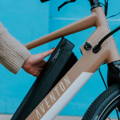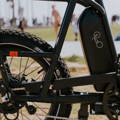If your e-Bike runs out of juice, you’ll have to pedal the old-fashioned way to make it back home. You’ll notice it takes slightly more effort to pedal due to the added weight and slight motor resistance. There are long-range electric bikes with higher capacity batteries, so there’s less of a chance you’ll run out of charge.
E-Bike Efficiency: How to Optimize for Speed vs. Range
Written by: Rémy Rossi | June 25, 2025 | Time to read 4 min
Want to increase your e-Bike range? The secret isn’t under the hood— it’s limiting your speed and using your legs.

More about the Author: Remy Rossi
Rémy Rossi is a bike writer, mechanic, and educator who got his start in community-based bike shops and co-ops. With a decade in the industry, he still wrenches on bikes when he can and plays bike polo on a fixie.

I remember the Mythbusters episode about whether road rage decreased fuel efficiency, surprised at the result that driving angry actually does reduce fuel efficiency. I’ve debunked electric bike myths before, and today’s sciency subject is how to balance e-Bike speed and range. There’s a lot that can affect an electric bike’s range, and reducing your speed can go a long way in traveling further on a single charge.
Factors that influence e-Bike range

Motor efficiency affects battery range

Hub motors directly turn the wheel, so they are operating under similar conditions most of the time, but mid-drive motors can leverage the bike’s gearing to stay as efficient as possible as speeds and slopes change. Slotting into the right gear when climbing a hill helps you keep the right pedaling cadence and allows the motor to maintain higher RPMs, where it is most efficient.
Reduce your speed to significantly increase range

Traveling faster on an e-Bike will draw significantly more energy from the battery. For every additional MPH gained, the reduction in range can be serious. From my research, I found that riding at 25 mph more than doubles energy consumption compared to riding 15 mph, and the effect can often be even more severe. Speed, rather than motor RPM or other power factors, has a much larger impact on the range of your e-Bike.
And while higher speeds can lead to a drastic drop in range, rider effort can significantly improve range. Instead of riding solely on throttle mode or higher pedal assist levels, putting in some human pedal power is very effective at extending range. For example, putting in a moderate effort of around 100W can decrease energy consumption by around 30%. For daily commuters on city e-Bikes or adventures on electric mountain bikes, this benefit can really add up.
Frequently Asked Questions
What happens if my e-Bike battery runs out of charge?
How do I know when my e-Bike battery needs to be replaced?
Over time, e-Bike batteries gradually wear down through normal use, diminishing their capacity to hold a full charge. As a result, you’ll notice a decline in the distance your bike can travel on a single charge. While there’s no fixed lifespan, a noticeable drop in performance—especially if it affects your daily riding habits—is a clear sign that it’s time for a replacement.
Will it cost money to recycle my used e-Bike battery?
No, you can typically hand in your old or defective e-Bike battery free of charge to specialized bike shops, which will take care of it properly and send it to a recycling facility. Some waste or e-waste facilities charge a use fee to dispose of material.
Key Takeaways
- Speed decreases your range: Riding at 25 mph can more than double your battery drain compared to 15 mph. Slow down to go farther.
- Gear smarter, not harder: Mid-drive motors perform more efficiently when paired with the right gear, especially uphill.
- Your legs are your battery’s best friend: Even a moderate pedaling effort can reduce energy consumption by around 30%.


